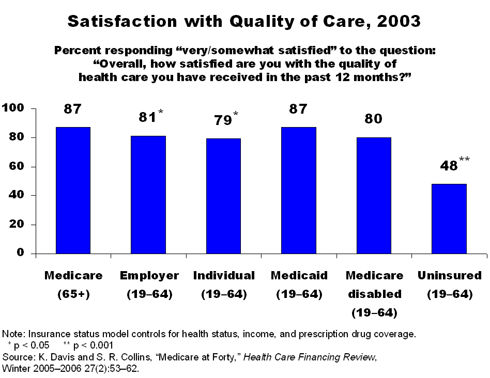In the Literature
When Medicare was enacted in 1965, more than half of elderly Americans were uninsured. Seniors lost their health insurance when they retired, and private insurance companies were reluctant to provide coverage to them. Since that time, Medicare—now in its 40th year—has achieved its two basic goals: protecting elderly and disabled Americans from burdensome medical care bills and ensuring they get needed health care.
In "Medicare at Forty," (Health Care Financing Review, Winter 2005–06), Commonwealth Fund President Karen Davis, Ph.D., and Senior Program Officer Sara R. Collins, Ph.D., look back at Medicare's successes, describe its challenges as health care costs rise and waves of baby boomers face retirement, and suggest policy options to ensure health and financial security for all Americans.
Beneficiaries Satisfied with Quality, Access to Care
Medicare beneficiaries report a high level of satisfaction with the program, and with the care they receive. Compared with the under-65 population, beneficiaries report better access to health care services and financial protection from medical bills. They are less likely to go without needed care because of costs or to report access problems, like skipping a medical test or not seeing a specialist when needed. The most common access problem for aged Medicare beneficiaries—not filling a prescription—is likely to change with the implementation of the new prescription drug legislation. This may be a particular boon for low-income seniors, say the authors, who stand to benefit from subsidies.
Challenges to Providing Care: Racial Disparities and Rising Costs
Although Medicare was instrumental in desegregating U.S. hospitals—due to requirements under Title VI of the Civil Rights Act—racial and ethnic disparities persist. Black and Hispanic elderly patients are less likely than their white counterparts to receive preventive services such as influenza vaccinations. Likewise, black beneficiaries are less likely than whites to receive chronic care services and experience good outcomes for conditions like diabetes.
Another challenge facing Medicare is rising costs, which have been a recurring source of concern since the program began. Medicare has had somewhat slower spending growth than have private health insurers, mainly due to the structured payment systems and regulatory controls of the program. Under the new prescription drug legislation, however, the government is prohibited from setting or negotiating pharmaceutical prices. This failure to leverage Medicare's power as a purchaser may come at a considerable cost, say the authors.
Future Policy Options
With increasing costs and an expanding pool of enrollees straining the federal budget, new strategies are needed to encourage people to save for health care expenses in retirement. One option is the creation of Medicare Health Accounts. These accounts, managed by Medicare and invested in government securities, would give working-age adults the option of setting aside a portion of wages to meet expenses not covered by Medicare, like premiums or long-term care expenses. Nearly 70 percent of working older adults would be interested in such an option, according to a recent Commonwealth Fund survey.
Another strategy for curtailing costs and limiting complexity is to offer a comprehensive benefits package for beneficiaries who wish to remain in the fee-for-service program. Such coverage, dubbed Medicare Extra or Part E, could help eliminate confusion for beneficiaries, as well as cut expenses by reducing duplicated and unnecessary administrative expenses.
In addition to complex coverage, many Medicare beneficiaries have complex care regimens, a result of chronic conditions that require multiple care providers. Investment in information technology tools could help streamline care, while reducing errors and costly duplication of tests. For the sickest Medicare patients, innovations in care management, like advance practice nurses who provide follow-up care to high-risk patients, could reduce costs and improve outcomes.
Through its leverage as a purchaser of health care services, Medicare has enormous potential to improve the quality of care for all Americans. Medicare could restructure its payment system to reward high-quality, highly efficient providers. In addition, Medicare could create networks of top-performing hospitals, specialists, and primary care physicians and offer incentives to beneficiaries who use their services.
Conclusion
Medicare has served beneficiaries well in the past 40 years. In order to continue to meet the needs of present and future enrollees, the program must promote innovative strategies and make health care more affordable. "These steps could help ensure that Medicare is up to the challenges of the 21st century, and continues to achieve a high level of public support and acclaim from beneficiaries," say the authors.
Facts and Figures
- Medicare is one of the most widely supported government programs among voters of all ages.
- Medicare currently covers only 58 percent of beneficiaries' health care expenses.
- Nearly one-half of older adults ages 50 to 70 have less than $50,000 in retirement savings.
- Per-enrollee Medicare spending grew at an average of 9 percent per year from 1969 through 2003—slower than the 10.1 percent average annual growth rate for private health insurers.



